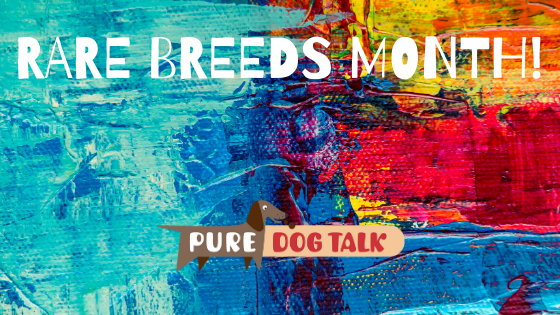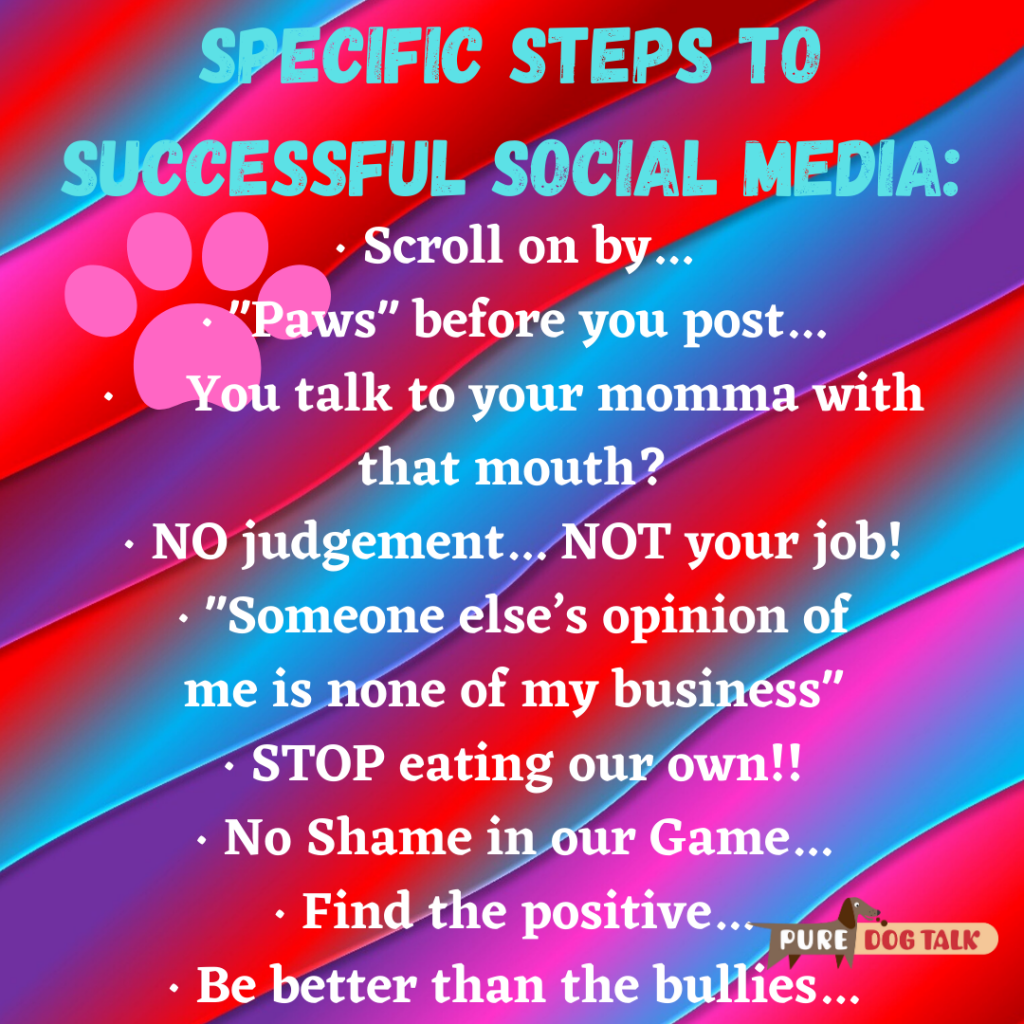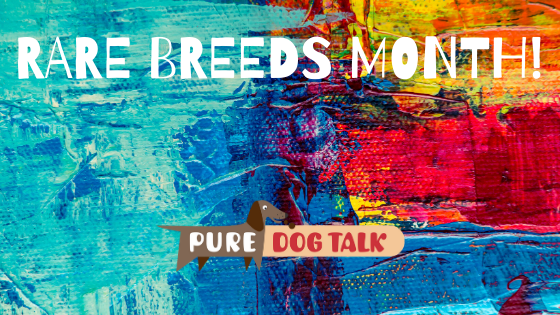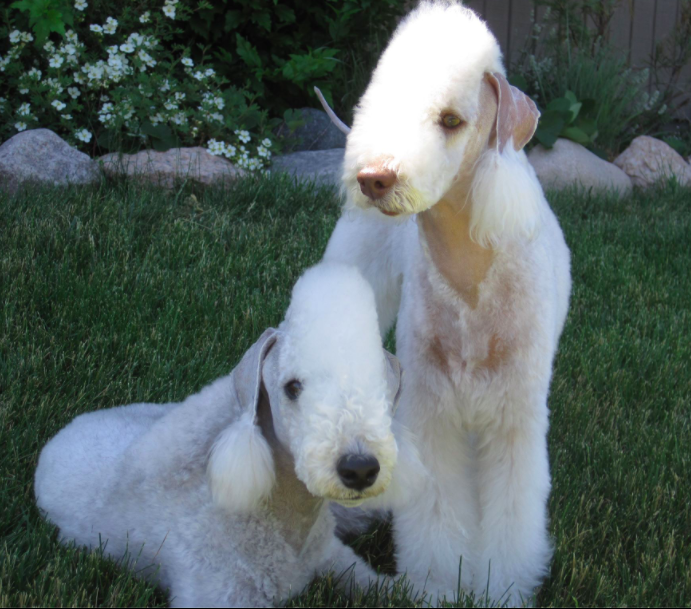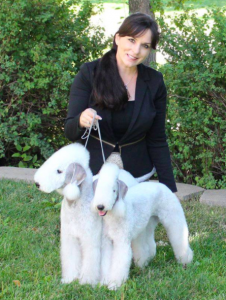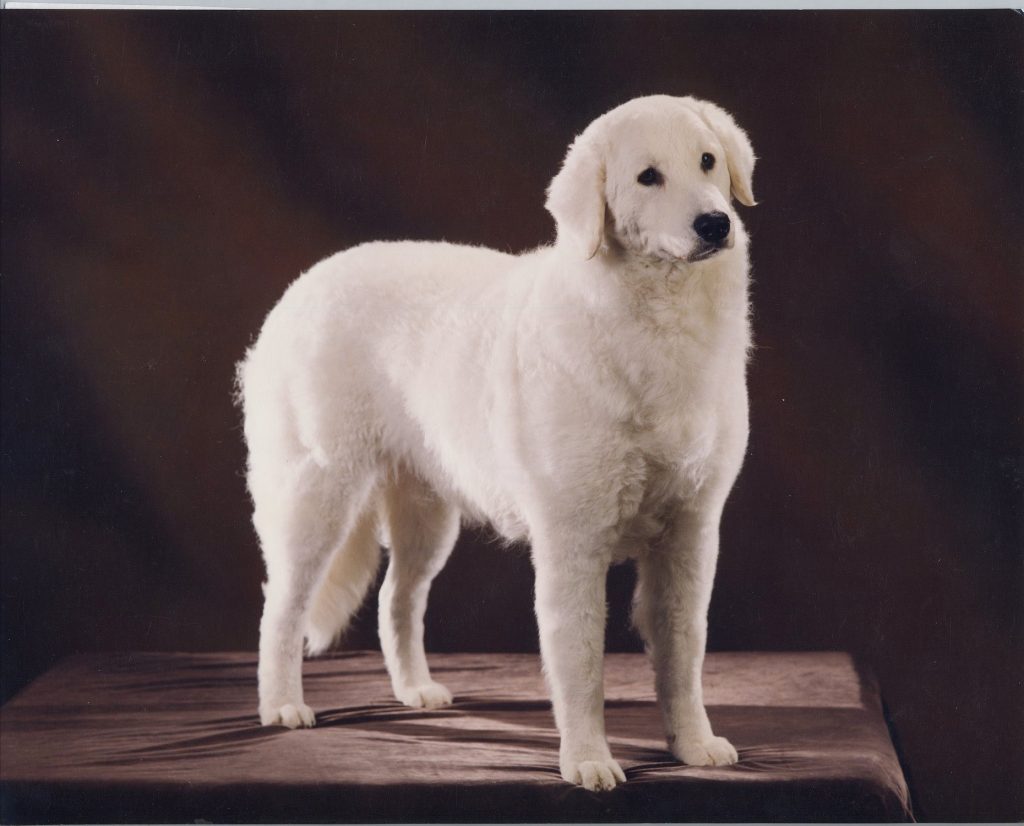Posts by Laura Reeves
389 – Working Together Leverages Resources in Rare Breeds
Work Together to Leverage Resources in Rare Breeds
Dawne Deeley and Amanda Kelly are back for the second half of our conversation about rare breeds and their unique challenges.
Who buys our dogs and why?
“It behooves us to think about the drivers for ownership,” Kelly said. “What is it that our breed offers that no other breed offers? What are the challenges that are unique to our breed? What are the barriers for people to consider getting one? Are they not getting any of these rare breeds because they’ve never heard of them? Or are they not getting them because there’s something about them that is maybe not with the average home is looking for? I think that in itself is a really important thing that we all need to understand and think about.
Set up for success
“We can breed the most beautiful dog in the history of the world but 99.9% of anything that we breed is going to go to a pet home… So what are we doing in order to ensure that we’re setting our dogs up for success … setting individual dogs up for success in the homes that they go to has an exponential effect in having people that meet them be more interested in every dog we breed. (They are) ambassadors for our breed.
“My background is in marketing and communication. So I tend to think about things kind of from the perspective of pushes and pulls. We push out information, but we also need to have a pull … we need to have people who are just interested in (the breed) and we need to figure out how we get the breeds in front of them and how we match up our breed with the right home.
We’re all in the same boat
“These breeds that are lower number, they’re the canary in the coal mine. A lot of the more popular breeds … registrations in general are falling. It’s something that the entire dog fancy is facing together. There’s power in numbers and we all have an opportunity to work together, pooling resources, small breeds coming together to do big projects. There’s lots of opportunities to do things, but we have to first recognize that we’re all kind of in the same boat.
“One of the examples that I can give you, a thing as simple as a pedigree database. Something that people can go online and look up pedigrees and do coefficient of inbreeding calculations or different tools that we might offer … breeders in other breeds may not think of that as such a big thing, but it’s just proving to be beyond our reach.
“If there’s opportunities that we can work with other clubs to do things, even something as simple as having access to a teleconference line to have meetings for your club. Our national breed club has struggled with technology, with a lot of older members who can’t figure out how to use Skype or FaceTime … until last year we were having our national breed club meetings in a chat room and typing back and forth to one another … so there are opportunities to help, to support one another, to come together across breeds, to make things happen that will lift us all up, that I think that we need to think about.”
388 — Auntie Laura Takes on Social Media Bullying
Auntie Laura Takes on Social Media Bullying
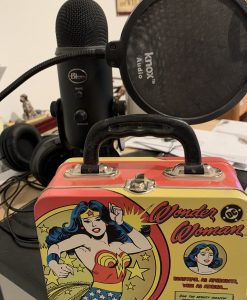 We’re going to talk a little something today. This is going to be a little bit of vintage Auntie Laura. We’re going to roll out a little bit of carrot and the stick. A little bit of whoop ass. Because there’s things going on in our world that need addressing. We’re going to talk about bullying and we’re going to talk about burnout … I have a special guest I’m going to bring on here shortly. But first I’m going to start with a little bit of a story.
We’re going to talk a little something today. This is going to be a little bit of vintage Auntie Laura. We’re going to roll out a little bit of carrot and the stick. A little bit of whoop ass. Because there’s things going on in our world that need addressing. We’re going to talk about bullying and we’re going to talk about burnout … I have a special guest I’m going to bring on here shortly. But first I’m going to start with a little bit of a story.
… I was that kid. In elementary school. I was that kid that the boys at the bus stop stole my Wonder Woman lunchbox and threw it under the bus. I was that kid. I was bullied because I was different. I was bullied because I was a girl. I was bullied because I reacted to it.
I learned and I turned into an angry little kid. If somebody tried to bully me, I kicked them or I bit them. I was a horrible child. It has taken me a long time to learn about life and to learn how to deal with some of these things … one of the things that I’ve learned over time is that bullies need one of two things or both. They need attention and they need oxygen. If you don’t give it to them, they go away.
So, in the microcosm of the world in general, in the midst of shut down when everybody is stressed out and freaked out, we come to the microcosm of dog shows where everybody is really stressed out and freaked out. And then we throw in a little social media and it gets a little carried away.
Dale Martenson is going to help me. He’s going to be the voice of reason, ’cause I can get a little hot under the collar on this topic. So, we’re going to talk today about some very specific ways that we can deal with properly harnessing our frustrations. Properly using social media. And just basically dialing it back a notch.
Dog shows, when I started … a kid that had been bullied my whole young life… dog shows and dog people and the dog community are where I found acceptance. I found family and I found peace and I found an opportunity to grow and excel that I did not have elsewhere… I was brought into the tribe and into the fold and accepted and nurtured and raised up. I believe that we have now lost our way.
Find a positive instead of looking for someone to tear down. Instead of looking for someone to trash who doesn’t agree with you. Instead of looking for a fight. Go find something good to do with your time and be better than the bullies.
Compassion and kindness and thoughtfulness … those are the things that our world needs … I really, really, really mean it you guys. This is not how we act.
A point of clarification for the peanut gallery. Having an opinion and even expressing said opinion do not constitute bullying. The line is crossed when individuals start name-calling and even threaten reprisals against those with whom they do not agree or have expressed differing opinions. Learn more about social media bullying and what you can do if you are the target here: https://www.helpguide.org/articles/abuse/bullying-and-cyberbullying.htm
387 – WHAT Are Rare Breeds and WHY are They Rare
WHAT Are Rare Breeds and WHY are They Rare
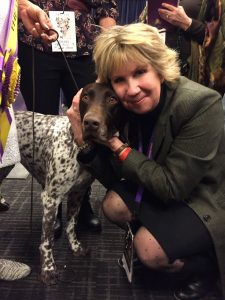
Susi Szeremy, working media at Westminster Kennel Club, with BIS winner GSP, CJ.
Susi Szeremy, founder of National Purebred Dog Day, joins host Laura Reeves to talk rare breeds, the #NPDD Photo Contest and celebrating our purebred dogs on May 1. Enjoy this excerpt of our fun and fascinating conversation. Click the play button to hear all the details in the podcast.
“What is a rare breed and why is it rare,” Szeremy asks. “I suppose that rareness is determined by our experiences … I recently observed that if you and I have never seen an example of a breed, given all of our travels at dog shows, it’s either because it really is a very rare breed or it’s a working breed that hasn’t experienced a push for recognition amongst more established registries.
Low Numbers or No Exposure
“For example, there is a Blue Lacy. There is a kelpie. I’ve not seen either of them because they don’t belong to any registry that I’m aware of. There’s not a push to get them recognized, but it doesn’t mean they don’t exist. In fact, the Blue Lacy is the state dog for Texas. It’s a very cool dog, named after the Lacy family, not because it’s like blue lace, but it is a wicked working dog and so is the Kelpie. Unless I hightail it down to Texas or Australia, I’m unlikely to see either of these dogs anytime soon. Conversely, I find it interesting that just four years ago the AKC put out an article entitled ‘11 rare dog breeds you never knew existed’ … I know I’ve seen every one of those breeds. They are considered rare according to this article. What I consider rare is something that I’ve never seen.
Vulnerable breeds
“I think it’s a perfect storm of different elements. Now, I make a distinction between what breeds are vulnerable in the UK and what breeds are vulnerable here. In the UK, there are 13 breeds that are coming in at 100 registrations as of 2019. That is in their country of origin. That’s how they make it on that list, if that was their country of origin and they have fewer than 300 registrations each year, in the UK they are considered a dog that cannot sustain itself moving forward unless they get over that 300 mark. And there’s 13 of them. I think the worst number that I saw in 2019 belonged to the Irish red and white setter and that only had 39. The Otterhound, I think surprisingly, came up a little better at 44. But worldwide there’s maybe 800 Otterhounds, which I don’t understand because it is a scruffy wonderful dog. Yeah, we don’t hunt otters anymore, but in my opinion an Otterhound can be repurposed… to track and trail.
Too much Choice or No Choice…
“So far as why I think this is happening to some breeds, I think among the reasons is too much choice and no choice. Let me explain. We’re getting more and more breeds known to the public. So there’s more choices for them to pick from if they go to a breeder. However, the adopt don’t shop and rescue world has had its impact. So if you’re vulnerable to feeling the guilt that you must adopt and you must rescue then your choices are very limited because I don’t think you’re probably going to find a rescue Azawakh.
Societal changes
“I think size is not all of it because I think a lot of people are inclined to say ‘well the dogs are very big and people don’t want big dogs anymore.’ Yet the King Charles spaniel, 93 dogs in the UK last year were registered, and that’s a small dog. It’s a marvelous dog. I think the culture has changed as well. We are living in more urban settings. We’re closer together, so a hound that bays is probably not going to be appreciated by our neighbor.
“We don’t hunt as much … so we have less land … we live on less land and there is less land available to people to hunt on. People I think are vulnerable, if they don’t do their homework, they see a dog on TV or in the movies that they fall in love with because the dog has a character. The character’s portrayed as having a quirky personality. People fall in love with that personality, not necessarily thinking or realizing that that may be a character written in but the actual breed itself comes with a different set of attributes. If they don’t do their homework, they’re going to be disappointed.”
386 – Protecting Diversity and Sharing Quality in Rare Breeds
Protecting Diversity and Sharing Quality in Rare Breeds
Host Laura Reeves is joined by two of North America’s most successful breeders of rare and threatened breeds, Amanda Kelly, Fwaggle Toy Manchester Terriers and Dawne Deeley, TsarShadow Karelian Bear Dogs.
These two talented women share their insights, perspectives and guiding principles in preserving their breeds and moving forward into the future.
Diversity not division
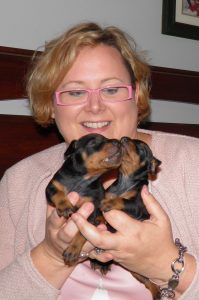
Amanda Kelly
“One of the things I personally really hold as a strong belief when it comes to breeding is that diversity of opinion and action within our breeds is what really protects the diversity in our breed,” Kelly said. “So, all of that to say that the fact that I’m doing what I think is right and you’re doing what you think is right is what’s important. It doesn’t matter if those are the same things. In fact, it’s probably more important that we’re all doing different things. Being able to accept that there’s a thousand ways to skin a cat, for lack of a better example, is a really important thing when you’re working in a rare breed. You have to appreciate the fact that there is more than one road that can be traveled.
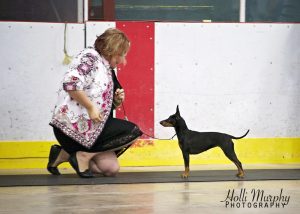 “One of the advantages of having been around for a really long time is that you know who everyone is and you know who likes who and who doesn’t like who and … where all the skeletons are in everybody’s closet. One of the things that I have found most interesting is looking back over two or three or more decades, that you’re always going to have popular lines. You’re going to have popular sires. And there’s going to be dogs that come in and out of fashion from different lines. But when push comes to shove and you’ve bred yourself into a corner or there’s just a lack of diversity because everyone has used the same dog, the places that you end up going are often places that were created out of a rift… you know a big hatred — breeder X hates breeder Y and so breeder X would never have anything of breeder Y’s in her line etc etc … and not that I would ever encourage it because I think getting along is also really important, but when you look 20 years down the road and everyone who has breeder Y’s dogs are now going to breeder X with their line because that’s where the diversity is….”
“One of the advantages of having been around for a really long time is that you know who everyone is and you know who likes who and who doesn’t like who and … where all the skeletons are in everybody’s closet. One of the things that I have found most interesting is looking back over two or three or more decades, that you’re always going to have popular lines. You’re going to have popular sires. And there’s going to be dogs that come in and out of fashion from different lines. But when push comes to shove and you’ve bred yourself into a corner or there’s just a lack of diversity because everyone has used the same dog, the places that you end up going are often places that were created out of a rift… you know a big hatred — breeder X hates breeder Y and so breeder X would never have anything of breeder Y’s in her line etc etc … and not that I would ever encourage it because I think getting along is also really important, but when you look 20 years down the road and everyone who has breeder Y’s dogs are now going to breeder X with their line because that’s where the diversity is….”
Why Such Low Numbers?
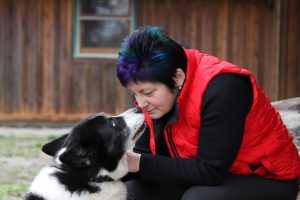
Dawne Deeley and ‘Eenokki’ dog, multi International Ch/World Winner/Nordic Winner/Finnish Winner/MBIS Can.Ch. TsarShadow’s The Berserker
“Historically (Karelians) are a very tough, single-purpose breed,” Deeley said. “In the Nordic countries up until I would say 2015, the Bear Dog was always in like the top 10 or at the very top 20 because we’re talking countries with an entirely different societal MO to North America. I mean I like to joke that every Finn is born with a cell phone in one hand and a rifle in the other. And every Finn hunts. I’m not exaggerating. Everybody. The women hunt birds. The guys hunt. Every Finn I know shoots something and it’s to put meat on the table. It’s their way of life. It’s what they do. The Swedes aren’t much different. Neither are the Norwegians. So this is a breed that was developed with a very specific purpose and it was to hunt big game. You had Finnish Spitz and finish hounds for hares and for birds. You had Bear Dogs for moose and bear. And that’s all they did. So now … progress marches on and now we’ve got dogs that are expected to do more things. We have governments that are saying ‘no, no, you know hunting is bad. You’re a horrible person if you hunt … especially in North America we have that way of thinking where ‘oh my god how could you actually shoot an animal.’
Finding the right homes
“My mom always said, ‘Choose the quality of the home over the quality of the opportunity,’” Kelly said, adding that her family’s breeding program always emphasized keeping prices fair and accessible for families.
Deeley agreed that show homes are not her first priority.
“My contract stipulates if somebody buys a dog as a show prospect that I will guarantee that I will show it and I will do everything in my power to finish it,” Deeley said. “Usually people either say well yes that’s what I want, or that’s what I don’t want, and so that gives me a tiny bit of control over where the good ones go. I don’t breed often enough to have waves of dogs of that caliber. I would rather see a dog go to a good hunting home than a good show home to be perfectly honest.”
385 – Bedlington Terrier: “Head of a lamb and the heart of a lion”
Bedlington Terrier: “Head of a lamb and the heart of a lion”
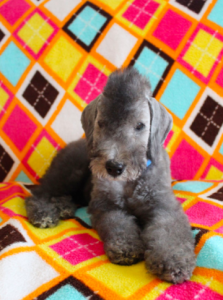 Three Bedlington Terrier breeders — Laurie Friesen, Gaby Gilbeau and Lucy Heyman — join host Laura Reeves during Rare Breed Month to share their passion for their unique dogs.
Three Bedlington Terrier breeders — Laurie Friesen, Gaby Gilbeau and Lucy Heyman — join host Laura Reeves during Rare Breed Month to share their passion for their unique dogs.
Kissing Cousins?
“So, what we know about the development of the Bedlington is kind of people’s best guess,” Laurie Friesen said. “We assume that they were bred with long-legged and short-legged dogs in a litter and the Dandie Dinmont actually evolved from the short-legged variety, where the Bedlington evolved from the long-legged variety. The Bedlington was sort of the poor man’s hunting dog and they used them for game to feed the family. They were very tenacious. As the Bedlington evolved they also, because of their tenacity, were used in other terrier breeds … I know the Lakeland has some Bedlington heritage. It’s also noted that when the hunt season was over, they were known to be pit fighters.
Laurie Friesen
“We have a saying in our breed that they have “the head of a lamb and the heart of a lion.” That’s one reason we don’t spar the Bedlington today. The other thing that’s interesting about the history and the hunting ability is we call them sort of a generalist. They were bred to course above the ground as well as go under the ground like your typical terrier.”
Versatile competitors
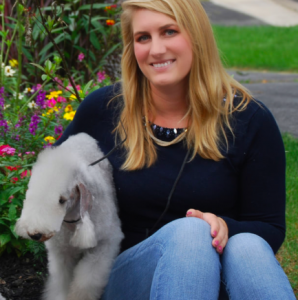
Gaby Gilbeau
“Building on that very colorful past,” Gaby Gilbeau said, “Bedlingtons are really kind of a Jack of all trades kind of dog. They are incredibly smart and unlike a lot of terriers, they’re actually very much people dogs. They really care about what their owners think. They are highly intelligent more in tune to what their owner is hoping that they will do, rather than some of the other terrier breeds which may have a little bit stronger of an independent streak. You see them at the highest levels of many of the events that the American Kennel Club offers. We compete in a huge range of activities with our dogs, from barn hunt and earthdog. They’re absolute machines on the coursing ability field. We’ve actually had some hunt masters ask us to run them against their whippets, just to  see which one will be faster.
see which one will be faster.
“I always say Bedlingtons are the dog world’s best kept secret. They are hypoallergenic. They don’t shed, so you have no doggy odor. They are rambunctious enough to still be active with a family with young kids. There’s some same sex (dog) aggression sometimes, but you know those are not extremely common. They’re great for families. They’re extremely active when you want them to be, like you’re gonna go on a five mile hike they’re game to tag along. But if you want to sit on the couch and watch Netflix all day, they are also cool to just hang out with you. They’re a very versatile dog that really fits a lot of different households.”
Grooming and Health
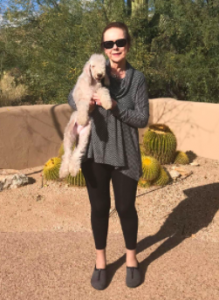
Lucy Heyman
“The Bedlington coat is very different from a poodle coat or Bichon coat or even a Kerry Blue coat in that it is quite unforgiving,” said Lucy Heyman. “You have to be extremely confident and skilled with the scissors in order to do it properly. That said, a lot of the grooming can be done with a clipper.
“It’s every 6 to 8 weeks with the groomers if you’re not going to tackle it yourself. I’ve had clients that have been able to tackle it themselves and turn them out looking like Bedlington should. It certainly isn’t beyond the average person’s reach if they work at it.
“For many, many, many years it was well known in the fancy and among the public that Bedlingtons had a disease called inherited copper toxicosis. It is essentially the same disease that humans have that’s called Wilson disease. This problem has been virtually resolved in our breed. There are very, very few dogs these days, well under 5%, that are affected when copper toxicosis.”
384 – Hungarian Breeds and Plato’s Theory of Forms
Hungarian Breeds and Plato’s Theory of Forms
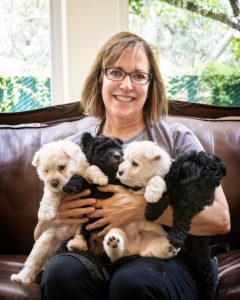 Maria Arechaederra’s passion for Hungarian breeds started early. She was about 10 years old, she said, when “flipping through the AKC breed book one day, I saw a picture of the Kuvasz. And it was like a lightning bolt. Love at first sight.”
Maria Arechaederra’s passion for Hungarian breeds started early. She was about 10 years old, she said, when “flipping through the AKC breed book one day, I saw a picture of the Kuvasz. And it was like a lightning bolt. Love at first sight.”
Plato and Breeding Philosophy
“To me you have to have a vision everyone understands how to read and dissect a breed standard. But if you don’t have a vision all it is is a bunch of parts. You know how a lot of breeds have an illustrated standard. I think those are great but I believe in being your own illustrator. Not that you’re an artist but in your mind you have to have that vision of what the perfect Pug or the perfect Kuvasz or the perfect Doberman is … when you look at your dogs you have to stack them up against that perfection. You can’t just say I want to fix rears the next generation, I wanna fix ears, you always have to be devoted to that vision.
“Look up Plato’s theory of forms … Plato’s belief was that there was a perfect everything in the realm of the soul, whether that be a chair or a tree or a dog. He said those exist in the realm of the soul and everything we see here on earth is just an imperfect version of that. I always joke that we are striving to build perfection, which is an impossible goal, but damn it, that’s the drive and the fun of it. We’re trying to create perfection.”
Kuvasz History
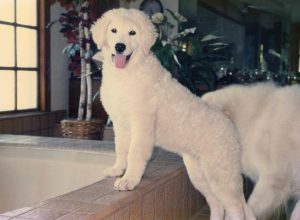 “OK the one beautiful thing about an ancient rare breed like the Kuvasz is that it’s survived the perils and tests of times of centuries of world wars. Even in their native Hungary they went from being livestock guards to the Royal dogs of the court of King Matthias of Hungary … he would have them in his Castle because according to legend King Matthias didn’t even trust his closest allies and guards more than he trusted his Kuvasz. So he always had them in the Royal Court and they also were used as napkins believe it or not people would wipe their hands on the white fur…
“OK the one beautiful thing about an ancient rare breed like the Kuvasz is that it’s survived the perils and tests of times of centuries of world wars. Even in their native Hungary they went from being livestock guards to the Royal dogs of the court of King Matthias of Hungary … he would have them in his Castle because according to legend King Matthias didn’t even trust his closest allies and guards more than he trusted his Kuvasz. So he always had them in the Royal Court and they also were used as napkins believe it or not people would wipe their hands on the white fur…
“To me that showed versatility, that this wasn’t just some kind of a wild animal out with the sheep. It could be even in a Royal Court as a personal guard … I can tell you personally from living with them and raising two children, that there is no greater babysitter than a Kuvasz. When my children were outside with a Kuvasz, I knew all was well with the world.”
Adding Pumik
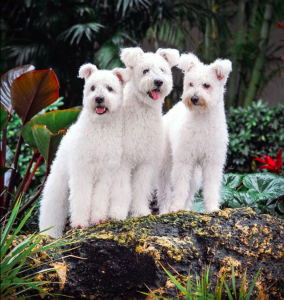
Left to Right:
“Bebe” (Ch. Ederra’s Meant to Be)
“Zsa Zsa” (Ederra’s Lovely to Look At)
“Sandy” (AKC and Bah Ch. Ederra’s Sabbia Bianca )
Bebe and Zsa are sired by Ziggy-multiple group winning Gch. Catskill’s Hajas Hippie and Sandy is sired by Casper (BIS/BISS/RBIS Gch. Italianstyle Casper)
“With my love of Hungarian breeds, (I thought) this is a perfect segue. I already know a lot of people in Hungary and I want (an) old age breed … that was a little bit of a misconception on my part, I will say, because what I found is that as cute as they are, they are every bit tough pound for pound herding dogs, with a very short off button. What they’ve done, inadvertently, is made me have to move more. So I guess it’s good for me, but I thought it was gonna be my old lady breed and actually they hike more than my Kuvasz, so I love that. I love them. They’re great dogs. They do like the sound of their own voice, so a lot of people don’t like the barking. They’re very vocal because the Pumi actually uses its voice as part of its herding tools.”
383 — Barbet: French Water Dog, NOT a Doodle
Barbet: French Water Dog, NOT a Doodle
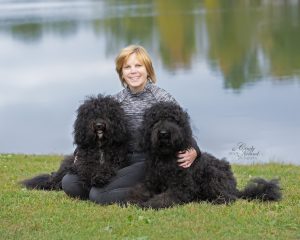
Judy Descutner and Barbet
Judy Descutner joins host Laura Reeves for a conversation about Barbet, the newest member of the AKC sporting group, in our continuing series for rare breed month on Pure Dog Talk.
“Being asked if they’re a doodle is a really good gateway to the fact that there is a purebred dog with a lineage that I can trace that is exactly what people are looking for who are buying a doodle,” Descutner said.
As a breeder, exhibitor, and long-time board member of the Barbet Club of America, Descutner has been instrumental in promoting the Barbet in the United States. Also involved with Whippets since 1985, she lives at Hickory Tavern Farm and is the delegate for the Western Pennsylvania Kennel Association.
History
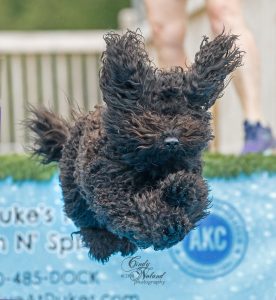 “Further back, obviously, they share a lot of relations with some of the other curly coated water dogs in Europe … definitely they share a lot with like the Portuguese Water Dogs and there’s some Irish Water Spaniel … the Barbet definitely has its own outline that makes it really distinguishable from the other breeds.”
“Further back, obviously, they share a lot of relations with some of the other curly coated water dogs in Europe … definitely they share a lot with like the Portuguese Water Dogs and there’s some Irish Water Spaniel … the Barbet definitely has its own outline that makes it really distinguishable from the other breeds.”
Water Party
“People think they’re a water dog that loves the swim, but they’re not. … they’re really good in the water, in fact you know they’re pretty strong to go through a marshy area and retrieve a downed bird that way. But they generally really like water that’s 1 – 1 ½ feet deep and they want to crash around in it … they’ve got to have that retrieving drive, like most of the retrieving breeds, but … they’re not a really strong driven breed. They’re certainly not like a field bred Labrador.”
Coat Maintenance
“It is a hair coat that always is growing and does need to be trimmed. So people with allergies, most of them do quite well with the breed, but of course you know there’s no such thing as hypoallergenic and some people are still gonna have problems with them. The coat itself can range from a wavy coat to a very tight curl … each coat probably has its own challenges to live with but no matter what it’s a high maintenance coat. Keeping it combed through to the skin and all the dead hair pulled out is a constant job. I think this is one of the things that’s super important for pet owners to understand … this is not a breed that gets to be just ignored. You have to trim, it you have to comb it out all the way to the skin.”
382 – Skye Terriers: Hardy, Devoted Breed of the Scottish Isles
Skye Terriers: Hardy, Devoted Breed of the Scottish Isles
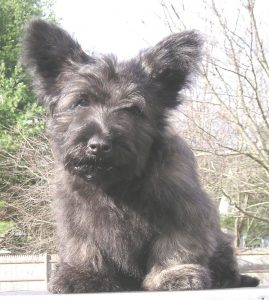
Skye Terrier puppy
Our panel of Skye Terrier breeders represents nearly 150 years combined experience in the breed. Michael Pesare, Elaine Hersey and Karen Turnbull join host Laura Reeves to share their love of this hardy, devoted breed of the Scottish Isles.
Depicted in art through centuries and with history dating back to the 1500s, the Skye is an old breed.
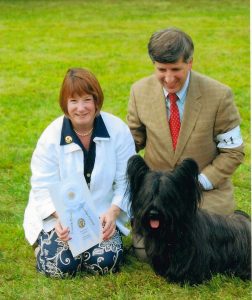
Michael Pesare
“The Skye definitely shares his heritage with a number of other terrier breeds from the Western Isles,” Pesare said, “the West coast of Scotland, where it can be quite rugged, damp, cold, rocky … breeds like the Cairn, the Scottie, the Westie… they were kept by the land owners to rid the farms of vermin. But not just small vermin, we’re talking Otter, Badger, foxes all the vermin that would do damage to the crops… there are references to long legged terriers and short crooked legged terriers going back to the 1500s, and so our Skyes definitely have a very long history.”
An achondroplastic breed, the long, low Skye is heavy bodied and heavy boned.
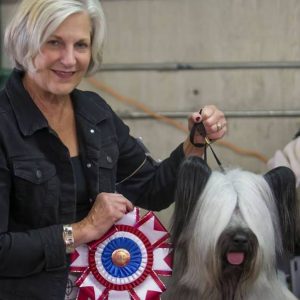
Karen Turnbull
“This is actually a very, very healthy breed,” Turnbull said. “I think because they’ve been rare that’s worked in their favor and there are very hardy breed, a sturdy breed … one question that we get frequently because they are a long and low breed I think people instantly think back problems. Our breed is not prone to back problems. The first thing I do when people say that is I invite him to feel the back and feel the legs. They’re always surprised because they have so much bone and there’s such a sturdy dog … people are always surprised at how much dog is underneath that coat.”
Made famous for their loyalty by the story of Grayfriars Bobby, the Skye is deeply devoted to its family.
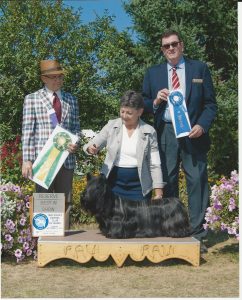
Elaine Hersey
“It’s a breed that wants to be with its person,” Hersey said. “They are very, very sensitive. They are very intuitive. They love their people. They’re not a breed that you can put out in the backyard and forget about. They need to have, I think, early socialization. They need to have continued socialization as a puppy if you want to have the best Sky you can. So they need somebody that’s committed to doing the work and then they’re going to have a wonderful, wonderful dog.”
For more information about the Skye Terrier, visit the Skye Terrier Club of America.
381 – Rare Breeds: Preservation, Promotion and Purposeful Breeding
Rare Breeds: Preservation, Promotion and Purposeful Breeding
Let’s kick off a month of Pure Dog Talk conversations, insights and ideas about rare breeds, preservation, promotion and purposeful breeding of these delightful dogs.
Today’s conversation is with Jennie Chen, breeder of Lowchen and Greater Swiss Mountain Dogs, Anna Wallace, breeder of Entlebuchers and Ian Lynch, Dandie Dinmont Terrier owner.
How to acquire a rare breed dog
Just acquiring a dog in a rare breed is one of the most difficult challenges, our panelists agreed.
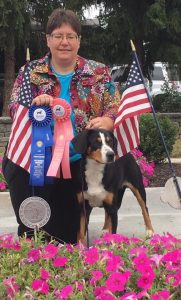
Anna Wallace and her Entlebucher
“I mean we’re absolutely protective of the dogs,” Wallace said. “So we have that aspect of ‘well we can’t keep them all we do have to place some of these puppies’ but we want to make sure they go into the right homes … can they benefit the breed in the long run… pets are very important because (they) become the ambassador the public sees … but we also don’t want to lose too much of our breeding pool in our gene pool to dogs that are going to ultimately end up neutered … so there’s a balance there and I know that’s one of the reasons it’s hard to break into (a rare breed). I actually broke in with a male ’cause it’s always easier to get a boy.”
Public education
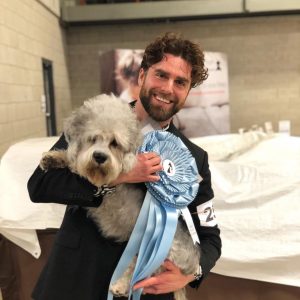
Ian Lynch with his Dandie Dinmont Terrier
Reaching the general public with information about our lesser known breeds is critical, especially younger people.
“I think a lot of times of millennials are kind of going back to our roots in a lot of ways,” Lynch said. “Like the farm to table eating, what’s old is new, what used to be called hand me downs is now called vintage clothing. I think a lot of people are really interested in history and I really liked the idea of being able to help a breed that needed a hand. I mean they say this in a lot of ways, that you could go to a shelter and you can save one dog or you can buy a rare breed, an endangered species. and save a whole breed of dog, the whole history of this dog can be saved.”
Social media
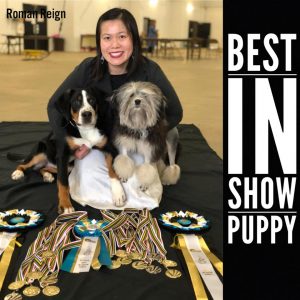
Jennie Chen with her Greater Swiss Mountain Dog and Lowchen.
Social media, particularly Instagram, including Facebook and Twitter, are great resources for reaching potential new owners. Our panelists agreed that young folks buy from social media and we need to reach potential owners where they are.
“I actually started in social media a little bit by accident,” Chen said. “’cause when I got my first greater Swiss mountain dog, I studied psychology and I’m all into early neurological stimulation early neurological training critical periods, I started *Keep Austin Dog Friendly… it is a list of restaurants in Austin TX where you could take your dog … I would go take my dogs out and I still do that today for socialization, for training and all that sort of stuff, and that website got really, really big … my dog became the face of *Keep Austin dog friendly… the website is still up … I even turned one of our website events into (my dog’s) birthday party … I use Instagram now quite a bit. A lot of my homes… create an Instagram specifically for the dog. I don’t have to get photos via email, they’re available all the time on my phone.”
Listen to the podcast for more insights, ideas and guidance from our outstanding panelists.
380 – Progesterone Timing for Pregnancy Success
Veterinary Voice: Progesterone Timing for Pregnancy Success
Dr. Marty Greer and host Laura Reeves talk about progesterone, that wonderful chemical inside our girl dogs’ bodies that tells us so much. Knowing progesterone levels is imperative for not only getting the bitches pregnant, but also keeping them pregnant.
“It’s really important from the beginning of the heat cycle to know when ovulation occurred,” Greer said, “because we know bitches are pregnant 63 days plus or minus 24 hours from ovulation. Normal pregnancy is not 58 to 72 days like we’ve been told for many decades prior to the time that we could do progesterone testing.”
“Get her pregnant and unpregnant by doing progesterone testing at the beginning of the breeding,” Greer said.
***
Veterinary Village LLC/ICSB-WI/IL
N11591 Columbia Drive Lomira WI 53048 Phone 920-269-4072 Fax 920-269-2345
veterinaryvillage.com vv@k9stork.com
Client handout regarding infertility:
Why isn’t my female pregnant? What can I do about it?
You did your homework – and have the perfect bitch, in her best condition and found the ideal male to mate her to. Both of them have passed all of the health clearances recommended for your breed. They have the temperaments you are looking for and their traits are complimentary to one another.
You know the most common causes of apparent or actual pregnancy failure are:
- Poorly timed breedings
- Poor semen quality and/or quantity.
- Failure to maintain a pregnancy
Timing the breeding:
The timing of the breeding, based on progesterone levels (bred 2 to 3 days post-ovulation depending on semen type used), was just right. Most veterinarians recommend breeding 2 days after ovulation with fresh and fresh chilled shipped semen and 3 days with frozen semen. Ovulation is assumed to occur when the progesterone reaches 5 ng/dl (different units are used in other countries) with a range of 4 to 10 ng/dl. LH testing is also done in some clinics. LH, Luteinizing hormone, directly indicates ovulation, while progesterone is an estimation of ovulation. Progesterone is easier to measure and test as it can be done every few days, using human technology. LH requires daily testing and is canine specific.
Semen quality and quantity:
You know the stud dog had good quality and quantity semen – there was a semen analysis completed prior to shipping the semen. Your vet looked at it prior to inseminating your bitch and said the semen looked great, based on the sperm count (for a Bernese Mountain dog, the count should be 1 billion total), the morphology (shape and appearance of each sperm cell) and motility (how active and progressively motile it was on a microscopic evaluation).
Yet, she is not pregnant. Why? And if you try to breed her again, what can you do differently to improve the chances she will carry a litter to term?
First, we need to determine if she failed to conceive, failed to achieve fetal/placental implantation, or conceived and lost the litter. If you don’t have her ultrasounded, you won’t know if she failed to conceive or failed to maintain the pregnancy. A relaxin test or palpation is not adequate – these do not assess for fetal viability. This information is big piece of the puzzle. When you are trying to justify the decision to do an ultrasound, this is the best reason to do so – this is not the place to scrimp.
If the ultrasound shows no pregnancy, and the semen and timing were good, then causes for failure to conceive or failure for fetuses to implant should be explored. These include:
- Was there a Semen quality assessment?
- Was the sperm count low?
- Was there abnormal semen morphology? Was the semen stained and assessed by a veterinarian?
- Was there poor semen motility? The semen needs to be progressively normal.
- Was there poor semen longevity? Holding a small sample of semen in extended in the refrigerator and reassessing it 24 and 48 hours later can be useful.
- Was there timing failure? This is a good time to review the timing of the breeding.
- Did she complete her ovulation?
- Failure to complete the ovulation. Did the progesterone testing continue past 5 ng/dl? If not, she may have not had a complete ovulatory cycle.
- Cystic ovaries? An ovarian cyst can interfere with a complete ovulatory cycle.
- Split cycle? If she failed to complete her ovulation, she may have split her cycle and will come back into heat in the next 4 to 6 weeks.
- Failure of adequate semen deposition: Fertile sperm must reach a fertile egg.
- If this was a natural breeding, was there a tie? Was the breeding witnessed? Was there a normal length tie?
- If this was a vaginal AI, was the AI performed correctly with no spermicidal exposure. Some lubricants and reusable equipment can have spermicidal properties. Using all disposable supplies is recommended.
- Does the bitch have a defect in her reproductive tract? Structural abnormalities causing failure of semen passage from the vagina to the oviducts including male and female anatomical abnormalities.
- Do either the male or female have Brucellosis? Canine brucellosis is a bacterial disease that can be spread venerally and can cause sterility in the male or female as well as pregnancy failure and early neonatal death.
- Was the bitch exposed to Canine Herpesvirus? – This is a viral disease that can cause early or late fetal death as well as neonatal death. In the adult, Canine Herpervirus causes mild respiratory disease. During early pregnancy, the fetuses can die at any stage, causing apparent failure to conceive if it is contracted during early pregnancy.
- Does the bitch have a bacterial infection in the vagina or uterus? A low-grade metritis, not rising to the level of a pyometra can interfere with conception. The difficulty here is that even in 2017, we cannot identify what normal bacterial flora in the reproductive tract is.
- Did she have another bacterial or viral disease that are not yet well characterized?
- Does she have a systemic illness? Any disorder that causes a fever can interrupt a pregnancy. Did she have a complete blood panel test, checking for signs of infection or organ disease? Consider testing for Lyme disease, Anaplasmosis, and Ehrlichia before you breed.
- Failure of the ovary to maintain progesterone high enough to support pregnancy (hypoluteoidism) Rarely, a bitch will have the inability to keep her progesterone level high enough to maintain pregnancy. This can occur as early as day 14 of the pregnancy. Testing her progesterone level at her pregnancy ultrasound can be an important tool.
- Does the bitch have abnormalities in her uterine lining? Cystic endometrial hyperplasia and fibrosis of the uterus can prevent normal placental development.
- Is there genetic incompatibility? If there are fatal genes, conception with pregnancy failure can occur. Line breeding dogs with too little genetic diversity can lead to small or no litters.
- Was there inadequate maternal nutrition?
- Raw meat diets can contribute to an imbalanced nutritional plane. Micronutrients and macronutrients must be adequate to maintain pregnancy. Bitches require carbohydrates to maintain pregnancy as well as to lactate.
- Does she have parasites? Parasite migration can lead to placental failure. The stress of pregnancy can lead to latent parasites starting to migrate again. Using Fenbendazole from day 40 of pregnancy to day 14 of lactation can protect the fetuses from this condition.
- Was the bitch subjected to trauma? Blunt trauma can cause the placentas to fail.
- Was the bitch subjected to undue stress?
- Did the bitch receive anesthesia, or inappropriate drug or hormones? Many of these drugs can be toxic to developing fetuses. All drugs should be avoided during pregnancy unless required to save the bitch’s life.
- Is the bitch Hypothyroid? Low thyroid levels can contribute to pregnancy failure or failure to conceive. This is a rare cause of pregnancy failure but should be considered if the levels are profoundly low.
If no underlying cause for failure to conceive is found, surgical breeding may be considered to improve the chances of success at the next breeding. Some bitches will conceive pups when surgical breedings are used to deliver the semen directly into the uterine body.
If the ultrasound shows a pregnancy was achieved but not maintained, this can result in fetal resorption (prior to day 45 of pregnancy) or fetal death and/or abortion (fetal loss after day 45 of pregnancy). This rules out poor timing, poor semen quality, or failure of semen to pass to the oviducts as causes for infertility.
Causes of failure to maintain a pregnancy include (see descriptions above):
- Brucellosis?
- Herpesvirus?
- Bacterial infections in the uterus. Cultures should be taken and antibiotics used if bacterial disease is suspected.
- Other bacterial and viral diseases that are not yet well characterized.
- Failure of the ovary to maintain progesterone high enough to support pregnancy (hypoluteoidism). Serial progesterone levels should be run if hypoluteoidism is suspected.
- Uterine lining changes that interfere with maintained placental attachment.
- Inadequate maternal nutrition.
- Trauma, stress, anesthesia or drug and hormonal interference.
A complete history should be taken. Diagnostics should include testing for brucellosis and Canine Herpesvirus. Cornell’s Veterinary Diagnostic lab has a blood profile called the “Canine Abortion Panel. Your veterinary clinic can submit tests for this. It is best done with paired samples, drawn 3 weeks apart and submitted together.
The pregnancy can be monitored for viable fetuses with repeated ultrasounds. WhelpwiseTM can be used to manage high risk pregnancies. Antibiotics, progesterone and terbutaline may be indicated if uterine irritability is shown to be putting the pups at risk. These drugs help quiet the uterus and can keep the pups safely in the uterus until they reach full term.
If no underlying cause for pregnancy failure or loss is found, uterine biopsy and cultures at about 60 days post-ovulation can be useful tools in determining if there is a treatable underlying cause and to help with determining a prognosis for future fertility. Treatment for causes suspected or found should be initiated prior to attempting the next breeding.
Fertility is never guaranteed. Your veterinarian can perform testing to assure you have the best possible opportunity to produce a litter.

